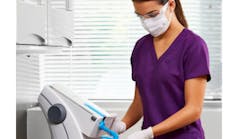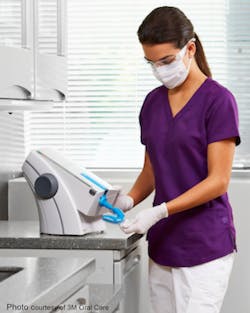Tips for dental assistants to perfect their impressioning techniques
When it comes to taking impressions, dental assistants need to maintain their skills in this area and keep up with the latest technology. Three dental assisting experts know the road well, and they want to share what they've learned.
_____________________________________________________________________________________________________________________________________
This article appeared in Dental Assisting Digest. Subscribe to the monthly e-newsletter designed just for dental assistants here.
If there’s one thing I’ve learned in my years of speaking to dental assistants around the country, it’s the fact that they can never acquire enough knowledge when it comes to improving their impression-taking techniques.
Certainly, THERE IS A LOT OF TALK ABOUT DIGITAL IMPRESSIONS AND THE IMPACT IT WILL HAVE on the dental industry. However, the tried and true method of taking impressions is still used by a majority of dental practices around the country. With that in mind, assistants need to maintain their skills in this area, and also stay on the cutting edge when it comes to learning about the newest technology in the materials that are being constantly introduced.
At IgniteDA, I’m lucky enough to work with some of the most experienced and respected dental assistants in the country. They include the three amazing women who helped me answer five questions about impression-taking that I think every dental assistant has asked at one time or another.
TRACY BUSH, RDA, started her career working in a general practice, and she has assisted with oral surgery, orthodontics, and endodontics. She began teaching dental assistants in 2009 at American Career College in Los Angeles and also currently serves as a substitute Instructor for the dental program at UEI College in southern California. She believes that dentistry is a very rewarding career and stresses the saying, “It’s your journey so make it a good and meaningful one.”
TIJA HUNTER, CDA, EFDA, CDIA, MADAA, is an expanded functions dental assistant/office manager in O'Fallon, Missouri. She is the director of the Dental Careers Institute, and a member of the American Dental Assistants Association, where she holds a Master. She is also an independent consultant specializing in team building, assistant training, and office organization.
ANGELA SMITH, BS, CDA, is a dental assistant from Richmond, Virginia. She is a dental assisting instructor at Reynolds Community College, teaches dental materials at the Virginia Commonwealth University Dental Hygiene program, and is a member of the American Dental Assistants Association.
Now that you know them, let’s see what answers they have to my five burning questions about assistants and impression-taking in today’s dental practices.
1. What is the biggest impression mistake you have seen dental assistants make?
Tija Hunter: The biggest mistake I’ve seen my students make is not getting a thorough mix. In practices I've observed, retraction also isn't always as good as it could be for such an important step.
Angela Smith: Overloading the tray with the impression material is the biggest mistake I see. The impression tray does not need to be overflowing with impression material to get a good or accurate impression.
Tracy Bush: The biggest mistake I’ve seen is improper water-to-powder ratio in the alginate mix. If your mix is too watery then the patient will gag and the mix will not set. If the tray is too small, you will notice the buccal surface rubbing on the second molars.
2. What is the best piece of advice you ever received about impressions?
Tracy: First, ask your patients to breathe through their nose and lift their left legs up in the air. You can make sure they are breathing through their nose by putting your finger up to feel their breath. If a patient is starting to gag, tell him or her to breathe through the nose and lift their legs higher. Another great piece of advice is to tell your patients to relax their cheeks and lips. This will make it easier to place the tray in their mouth.
Tija: Distract patients. Many people gag just from the thought of it, so distracting them and helping them get through it is essential. They certainly appreciate it.
Also, a colleague of mine told me a long time ago about 3M Impregum Soft Polyether Impression Material. I can truly say, without question, that it is one of the best materials on the market. It’s a polyether, which is much stronger and more tear-resistant than its counterparts. The best thing about it is that it’s hydrophilic, so when there is moisture in the area, it performs incredibly accurately. It’s very smooth and flows great to pick up detail. Assistants love the automix feature. It is virtually mess-free!
Angela: Don’t let a patient help. You need to be in control of the procedure when taking impressions.
3. What is the one thing a dental assistant can do to cut down on remakes?
Angela: Make sure to prepare properly. Have what you need at your fingertips and mix the alginate thoroughly.
Tracy: Use room temperature water to make sure your water/alginate material is measured correctly. If warm water is used, then your mix will set up too quickly. If cold water is used, then the mix will take a lot longer to set up.
Tija: Retraction. Get that lip out of the way! Paying attention to mixing, loading, and seating the tray is great, but if you don't get that tongue, frenum attachments, or lips out of the way, you'll have a retake. Picking up all the information you can for the impression is imperative.
4. If you could go back to your first day of assisting and tell yourself one thing about impressions, what would it be?
Angela: Confidence is key. Doubting yourself in anything will lead to poor results.
Tija: I would reassure myself that I can do it. It takes practice, and lots of it. You will learn from all of those mistakes you make, but you will rock it!
Tracy: I would tell myself to relax and breathe. Patients are, for the most part, forgiving. Remind your patients of the “tricks” mentioned above, then use your measuring devices. Ask your patients to lay back on the pillow or head rest. This will help relax them.
5. Where did you learn the most about how to take impressions?
Tija: Ironically, from a couple of amazing dental lab technicians. It is great to get their perspective. After all, they have to deal with what you send them. Garbage in, garbage out!
Tracy: I learned the most from simple trial and error. Learn to be a good listener, and you will be great! I tell students that they will learn a lot in school and during their externship, but that most of their learning will come with experience in the field.
Angela: Believe it or not, I’ve learned the most about how to take impressions by teaching others how to take impressions. For years, I was mediocre at this procedure. However, since I began teaching dental materials courses to assistants and hygienists, I have really found my ability to do it right the first time.
For the most current dental assistant headlines, click here.
For the most current dental headlines, click here.
About the Author

Kevin Henry
Cofounder, IgniteDA.net
With more than 20 years in the dental publishing industry, Kevin Henry is the former group editorial director for Dental Products Report and managing editor for Dental Economics. Currently, he is the editor-in-chief for DrBicuspid.com. He has spoken to dental assistants throughout the world, in person and through the Dental Assistant Nation podcast series, reminding them of the important role they play every day in their practice. He is also certified as a DiSC trainer, helping dental practices learn how to understand each other better through personality assessments and training.


